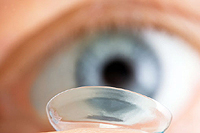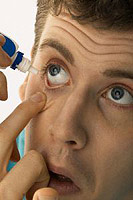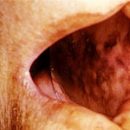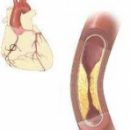Although keratoconus leads to blindness not in 100% of cases, the disease threatens a significant impairment of vision. On the signs and symptoms of this ailment, as well as about the principles of his treatment, read in this article.
Content
What is keratoconus
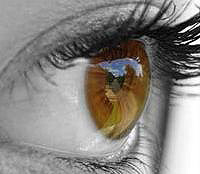 Word «Keratokonus» Consists of two Greek words: «kerato» - cornea I «Konus» - cone. Keratokonus or «Conical cornea» - The condition of the eye in which the normal spherical form of the cornea is broken. As a result of dystrophy and thinning of the corneal tissue, the cornea takes a conical shape, it is protruding and thinned, becomes uneven and sometimes scars are formed on it.
Word «Keratokonus» Consists of two Greek words: «kerato» - cornea I «Konus» - cone. Keratokonus or «Conical cornea» - The condition of the eye in which the normal spherical form of the cornea is broken. As a result of dystrophy and thinning of the corneal tissue, the cornea takes a conical shape, it is protruding and thinned, becomes uneven and sometimes scars are formed on it.
Why arises keratoconus? Keratokonus is known at least 200 years, but adequately describe it and distinguish from other diseases of the cornea only by the middle of the 19th century.
Causes of illness are still unknown. One of the scientific theories assumes that keratoconus has evolutionary, t.E. Genetic roots. According to another theory, the disease is a degenerative state.
The third point of view - keratoconus is the consequence of any other, primary in relation to it, disease. This idea is based on the fact that keratoconus can occur in children with weakened health, and usually amazes both eyes.
Another, less common, hypothesis speaks about the relationship of the disease with the endocrine system. It is based on the fact that keratoconus usually occurs in the period of puberty.
Symptoms of keratoconus
The rays of light are unevenly refracted at different points of the cornea due to its changed, cone-shaped. The light is so buncifully refracted on its surface, that a person seems to see the world around. Vision distortion with keratoconus can be compared with the view of the road sign, if you look at it through the windshield of the car in a strong shower. Astigmatism and myopia arises (myopia).
Naturally, the patient is primarily complaining about the reduction of visual acuity, the distortion of objects, the impossibility of clear visibility. In order to consider anything, he tries somehow especially squinting or tilt his head. However, unlike true (primary) myopia, such a patient's glasses cannot be chosen - they still do not give it satisfying its visual acuity.
The process of refined horny shell usually occurs for 5-10 years and then seeks to stop. Sometimes it will accelerately progresses and at its later stages the patient can suddenly feel a sharp cloud of view in a sore eye, which is gradually dissipated within a few weeks or months. This is a sharp swelling, it occurs as a result of fluid penetration into a stretched cornea. In the last stages of keratoconus, a cone-shaped corneal protrusion appears visible to the naked eye. In severe cases, surface scars are formed on the surface of the horny convexity, even more worsening vision.
How to treat keratoconus
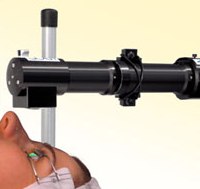 Actually treatment is not amenable to treatment. The role of medicine is practically reduced to the provision of opportunities to have acceptable vision. At the initial stages of the development of keratoconus, light astigmatism and myopia are arising, which can be corrected using ordinary glasses.
Actually treatment is not amenable to treatment. The role of medicine is practically reduced to the provision of opportunities to have acceptable vision. At the initial stages of the development of keratoconus, light astigmatism and myopia are arising, which can be corrected using ordinary glasses.
As the disease develops, it becomes not enough, and the only possibility to compensate for the curvature curvature remains the use of gas-permeable and soft contact lenses, which become the main means of correction for quite a long time. Contact lenses should be seized extremely carefully and carefully. Every day you should allocate time for resting eyes from contact lenses. Most patients require frequent checks and changes in the configuration of lenses to achieve good visual acuity and maintaining comfort. It should be noted that the continuous improvement of gas-permeable and soft contact lenses opens up all new opportunities before the patient. That is why the lenses should be used until the need for surgery.
Surgical operation becomes necessary only in 10% of cases. The very possibility of transplantation is resorted only in cases where the patient is not able to wear lenses or quality of vision remains insufficient contrary to the qualified assistance. During the operation, most of the central shell of the cornea is removed and replaced by the cornea of the donor. Full loss of vision is not excluded, but it happens in exceptionally rare cases.
Recently, the initial stages of keratoconus began to use an excimer-laser impact on the cornea to strengthen her bowman sheath. This operation is in essentially different from the FRC, carried out about ordinary myopia, but due to its therapeutic application «Phototherapeutic kerattectomy».
The modern market of ophthalmological services offers a new approach to solving the problem of progression of keratoconus procedure, the essence of which is to saturate the cornea with a solution of riboflavin and the further effects of UV radiation of fixed power, resulting in «Cementing» cornea with strengthening its structure. In the first phase of the procedure, special drops containing photosensitive components are buried, with an interval of 2 minutes. The second phase is the effect of the laser for 30 minutes on the cornea saturated by this substance. Thus, the progression of keratoconus and the refraction of the eye remains stable. At the end, the patient's eye is put on a bandage contact lens. The procedure can be carried out outpatient.
Pay attention to any change in the state of the eye or visual sharpness. If you feel tumping vision, itching, or eye irritation, we have tearing or any emissions from the eyes, then you need to see a doctor. These symptoms may, for example, be an eye reaction to the contact lenses and indicate the need to replace them. Women should use cosmetics with care. All people suffering from keratoconus should use special swimming glasses and safety glasses when practicing physical labor and sports.




